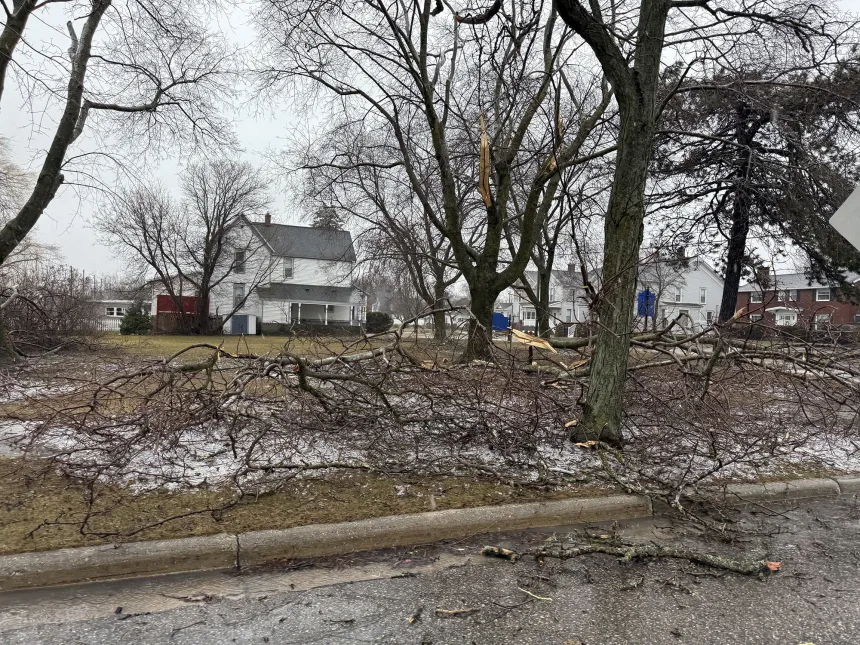As a dangerous and wide-reaching storm descends upon the Eastern Seaboard, tens of millions of individuals face significant threats from tornadoes, severe thunderstorms, and intense hail. This past weekend, the impact of these weather systems was felt across the central United States, resulting in devastating fatalities and extensive damage.
According to reports from the Kalamazoo County Sheriff’s Office, tragic incidents have unfolded in Michigan where three young children—a two-year-old and a four-year-old, both siblings, along with their eleven-year-old cousin—lost their lives when a tree uprooted by the storm landed on their vehicle. This unfortunate event reflects the magnitude of the risks posed by severe weather conditions, as Sheriff Richard Fuller noted, “It was a terrible scene to witness and respond to.” The sheriff’s office also reported injuries to three other individuals, who were presumably associated with the children, underscoring the havoc wreaked by these storms.
Furthermore, the storm’s trajectory has claimed the lives of several others across the Midwest. In Stockbridge Township, Michigan, a 57-year-old man succumbed to injuries sustained when a tree collapsed onto his home. In Indiana, a semi-truck driver in Valparaiso was killed when winds gusted to an alarming 80 mph, ultimately flipping his vehicle. Additional reports from Middlebury, Indiana, indicate that strong winds overturned an Amish buggy, tragically resulting in another fatality. In Cherokee County, Oklahoma, a thunderstorm led to a tree crashing onto a trailer, killing a man inside. The cumulative effect of these events paints a grim portrait of the storm’s intensity.
As the storm system continues its eastward march, it has left over 400,000 residences and businesses in the dark, with the greatest number of outages occurring in Michigan. The southern portion of the state has experienced severe thunderstorms, while ice storms have crippled the northern areas, bringing down power lines. In regions affected by thunderstorms throughout the South—particularly in Louisiana, Mississippi, Alabama, Georgia, and Florida—power outages also became prevalent.
On Monday morning, damaging thunderstorms intensified as they swept through the Southeast, culminating in significant impact on the Atlanta metro area. Hartsfield-Jackson International Airport, the busiest airport in the world, implemented a ground stop, leading to the cancellation and delay of over 800 flights. Charlotte Douglas International Airport in North Carolina faced similar disruptions.
Forecasters have classified the storm threats using a risk scale, identifying a level 3 out of 5 for severe thunderstorms from Georgia through North Carolina. Expectations of damaging winds, heavy hail, and potential tornadoes remain high, with flooding looming as a significant risk. The anticipated storms, which are already developing in the Appalachians, are forecasted to strengthen and spread along nearly the entire East Coast.
The National Weather Service confirmed multiple tornadoes across several states on Sunday, including Mississippi, Louisiana, Missouri, Arkansas, Tennessee, Illinois, and Michigan. Notably, the number of tornadoes reported in March has already surged past figures from previous years, indicating a concerning trend in severe weather activity. The storms have not only unleashed tornadoes but also hail, with reports of hailstones reaching the size of baseballs.
As the storms progressed, they compounded their destructive capabilities through heavy rainfall and flash flooding. Flash flood emergencies were declared in southern Mississippi as torrential rain fell, leading to hazardous conditions. This pattern mirrors trends of previous years, where spring brought a cascade of severe storm systems that culminated in an extraordinary number of tornado reports—numbering nearly double compared to the same period last year.
With forecasters suggesting that the potential for future severe weather remains high—spanning from Texas to the Midwest—residents are strongly encouraged to stay informed. Having reliable sources for weather updates and alerts is crucial, especially in areas at heightened risk for nighttime storms.
In conclusion, the cascading impact of these severe weather systems serves as a stark reminder of nature’s unpredictable power. As communities across the Eastern Seaboard rally to assess and recover from damages, the importance of preparedness and awareness stands at the forefront to safeguard lives against such tragedies in the future.

